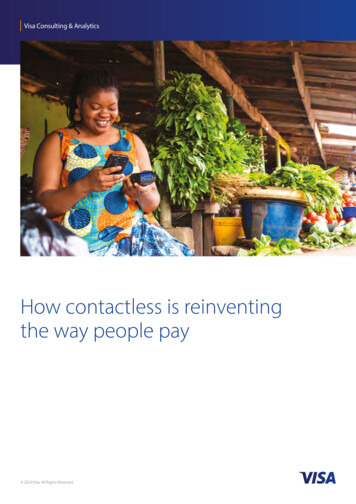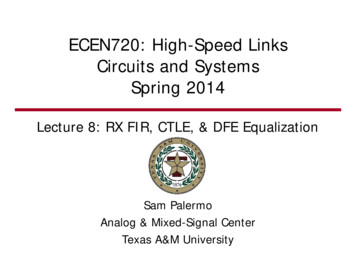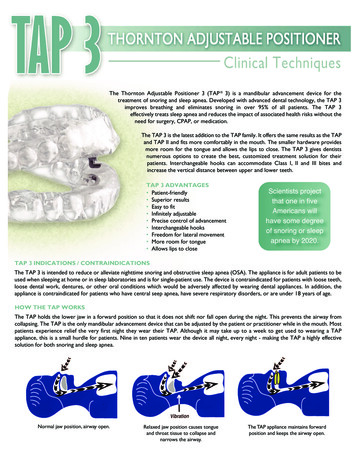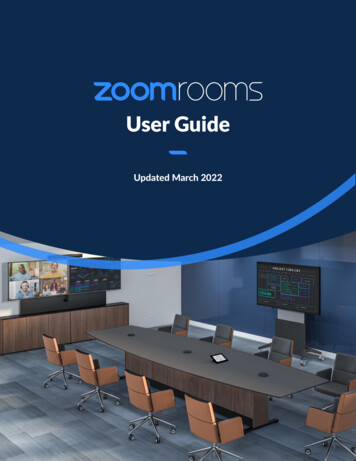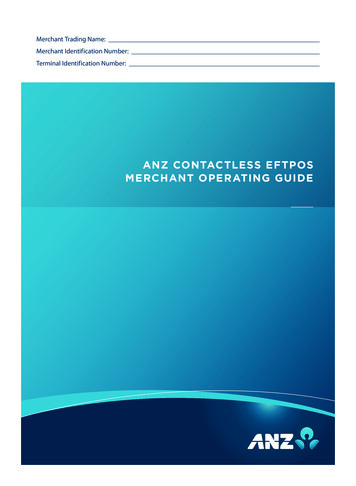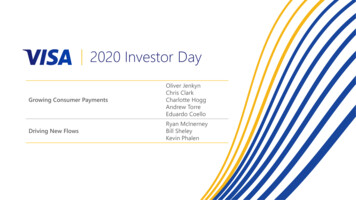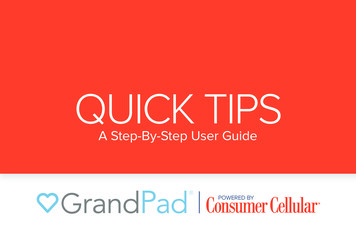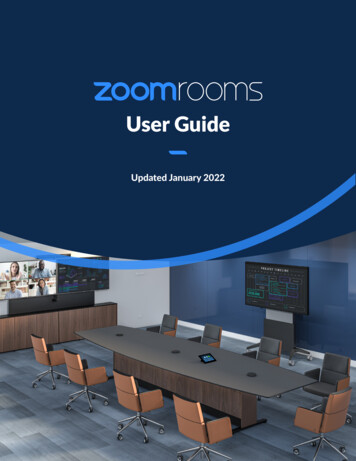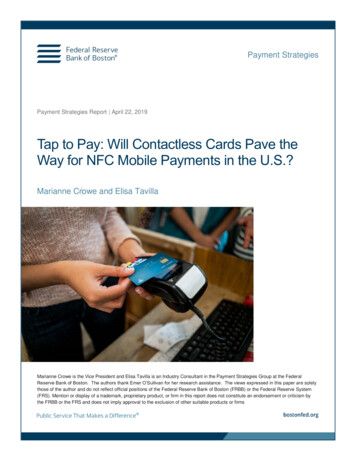
Transcription
Payment StrategiesPayment Strategies Report April 22, 2019Tap to Pay: Will Contactless Cards Pave theWay for NFC Mobile Payments in the U.S.?Marianne Crowe and Elisa TavillaMarianne Crowe is the Vice President and Elisa Tavilla is an Industry Consultant in the Payment Strategies Group at the FederalReserve Bank of Boston. The authors thank Emer O’Sullivan for her research assistance. The views expressed in this paper are solelythose of the author and do not reflect official positions of the Federal Reserve Bank of Boston (FRBB) or the Federal Reserve System(FRS). Mention or display of a trademark, proprietary product, or firm in this report does not constitute an endorsement or criticism bythe FRBB or the FRS and does not imply approval to the exclusion of other suitable products or firms
ContentsI.Introduction . 3II.Contactless Payments Evolution in the U.S. . 3A.Early Contactless Developments . 4B.Contactless Payments in Canada and the United Kingdom . 5C.Contactless Payments in the U.S. Today . 7III.Stakeholder Perspectives. 8A.Card Networks . 8B.Issuers . 10C.Processors . 12D.Merchants. 13E.Contactless Card vs. Mobile Phone . 14IV.Key Findings . 15 2019 Federal Reserve Bank of Boston. All rights reserved.
I.IntroductionAfter 15 years of industry stakeholder debates, trials and pilots to determine when contactless paymentswould take off in the U.S., all the components are finally in place to make it happen. This reportdiscusses stakeholder perspectives on the reality of issuance, acceptance, and adoption of EMV dualinterface cards, as well as the impact of contactless cards on NFC mobile payments.The findings reflect discussions with 12 stakeholders, representing card networks, financial institutions,payment processors, merchants, and technology providers, as well as secondary industry research.What are contactless payments?Contactless payment transactions require no physical contact between the contactless card or otherform factor (e.g., mobile device) and the point-of-sale (POS) terminal.1 To make a contactlesspayment, the consumer holds the contactless card, mobile, or other device in close proximity (1-2inches) to the terminal to communicate the payment account information wirelessly.An EMV dual-interface card combines contact and contactless technology. This card has anembedded near field communication (NFC) antenna2 that communicates with the POS terminal viaradio waves to send a dynamic cryptogram for each transaction. Cardholders either insert or tap adual-interface card at the POS terminal. Dual-interface cards provide the same security as contactonly EMV chip cards, with an improved user experience afforded by the speed of contactlesspayments.3 The terms dual-interface and contactless are used interchangeably to refer to EMVcontactless cards throughout this report.II.Contactless Payments Evolution in the U.S.The evolution of contactless payments in the U.S. began with the first magnetic stripe data (MSD)contactless card pilots in 2003, moving through the Apple Pay launch and migration to EMV chip cardtechnology in 2014, and progressing toward increased contactless acceptance and issuance of dualinterface cards by 2018 (see Figure 1).1The contactless card and POS terminal are compliant with the EMV Contactless Specifications.The antenna on a dual-interface card performs two functions: (1) enables power from the terminal to the chip on the card; and (2)transmits transaction data wirelessly between the chip and terminal.3For more information on dual-interface cards, see “Dual Interface Card Personalization,” U.S. Payments Forum, Sep 2018.2Federal Reserve Bank of Boston bostonfed.org Payment Strategies3
Figure 1: Evolution of Contactless Payments in U.S.2003U.S. contactlesspayment pilotsbegan in 2003.Some financialinstitutions,including Chaseand Wells Fargo,issued MSDcontactlesscards until 2014.Apple launchedApple Pay in 2014.FIs started providingcontactless paymentsvia NFC mobilewallets.2014 --- 2015 ----------- 2017 --- 2018 --------------- 2019FIs started issuing EMV contact-chipcards and merchants began installing newPOS terminals for the October 2015 U.S.EMV migration and liability shift. Somemerchants enabled contactless (whichrequired acceptance of all payment formfactors using NFC protocol).Some FIs started toissue EMV dualinterface cards forselect card productsor upon customerrequest, includingChase in November2018. 99% of top 200 U.S.retailers by transactionvolume are chip-enabled78 of top 100 U.S. retailersby transaction volume arecontactless-enabled100m contactless cardsexpected by end of 2019Wells Fargo startedissuing dual-interfacecards in April 2019New York’s MTA will beginaccepting contactlesspayments for transitA. Early Contactless DevelopmentsEarly MSD contactless cards contained magnetic stripe data, an embedded contactless smart chip, and asmall antenna that communicated with the POS reader through a contactless radio frequency interface.Cardholders paid by tapping their cards on the POS reader instead of swiping.4 Additionally, contactlesscards used encryption technology to generate a unique three- or four-digit card verification value (CVV)transmitted with each transaction to the issuer for authorization, along with other measures specificallydesigned to protect the security of the consumer’s payment credentials and transaction.From 2003 to 2005, a few large financial institutions (FIs), card networks and merchants launchedcontactless payment pilots in the U.S. American Express, Bank of America, Chase, Citibank, WellsFargo, and other FIs piloted contactless cards and other form factors, such as key fobs and stickers, withcustomers in select regions. The providers marketed their contactless technology as Amex Expresspay,Mastercard Paypass, Visa Paywave, and Chase Blink. Chase, the largest U.S. credit card issuer, was oneof the first to issue contactless cards commercially in 2005.The value proposition for contactless payments promoted convenience, speed, enhanced security, and apotential cash replacement. Consumers and merchants would benefit from ease of use, faster checkout,and more security by tapping a card or device instead of swiping a magstripe card or paying with cash. Inparticular, contactless payments offered a strong business case for merchants with high-volume, small4In the U.S., card networks supported pre-EMV contactless payment products based on ISO/IEC 14443, the international standardfor contactless smart chip. For more information, see “The What, Who and Why of Contactless Payments,” Smart Card Alliance,Nov 2006.Federal Reserve Bank of Boston bostonfed.org Payment Strategies4
ticket items traditionally paid with cash, such as quick service restaurants (QSRs), pharmacies, grocerystores, convenience stores, movie theaters/sports stadiums, and transit. Merchants that acceptedcontactless payments included 7-Eleven, AMC Theaters, Best Buy, CVS, McDonald’s, Walgreens, andRegal Cinemas. Some sports stadiums and New York’s Metropolitan Transportation Authority (MTA)participated in contactless payment trials as well.Despite the value proposition, the initial U.S. rollout of contactless payments did not come close toachieving the mass adoption that industry stakeholders had anticipated. Limited availability ofcontactless cards and low merchant acceptance made it challenging to incent consumers to modify theirpayment behavior, as merchants also had to add contactless readers to existing POS systems or purchasenew terminals. At the same time, customer benefits were not significant enough to make a notabledifference. For example, tapping was not much faster than swiping a card. Card networks had alreadywaived signature verification rules for some low-value swiped transactions, which reduced customerfriction at merchant locations that no longer required signatures.In 2008, the contactless card base had reached 50 million, but only 120,000 merchants accepted thecards.5 By 2014, as FIs began planning for the EMV chip migration, the quantity of contactless cards incirculation, cardholder usage, and merchant acceptance were all low. As a result, Chase and Wells Fargodetermined that the added cost to include the new chip in contactless cards was no longer worthwhile.They discontinued contactless card issuance and focused on issuing EMV contact-only cards.6 Today,most EMV chip cards issued in the U.S. are still contact-only.B. Contactless Payments in Canada and the United KingdomIn Canada and the United Kingdom (UK), most EMV cards are dual-interface and can be inserted ortapped at the POS terminal. Broad availability of dual-interface cards and merchant acceptance havecontributed to the growth of contactless payments in Canada and the UK by enabling consumers toincrease their comfort and familiarity with this payment method.Canada’s payment industry introduced contactless MSD cards in 2005, around the same time as the U.S.,but they did not gain traction due to limited merchant and issuer interest and inadequate stakeholderbenefits. When Canada began migrating its contactless cards to EMV chip technology in 2008, the appealof contactless increased, particularly the faster transaction times compared to contact-only cards.However, it was the liability shift in 2011 that incented more FIs to switch from contact-only to dualinterface cards, and merchants to install contactless-enabled POS terminals. As consumers began toexperience faster transactions afforded by dual-interface cards, they began seeking issuers and merchantsthat accepted contactless cards.Today, almost all credit and debit cards issued in Canada are dual-interface, and almost all merchantsaccept contactless payments. Figure 2 illustrates the rapid growth of contactless payments in Canada.Volume and Canadian dollar (C ) value grew from 215 million transactions and C 9.66 billion in 2012 toJim Daly, “Contactless II,” Digital Transactions, Apr 2, 2018.“Blink Waves Bye-Bye to Contactless Forever?” PYMNTS.com, May 12, 2014. EMV chip cards generate dynamic cryptogramsunique to each transaction that prevent fraudsters from using stolen card credentials to create counterfeit cards for POStransactions.56Federal Reserve Bank of Boston bostonfed.org Payment Strategies5
over 3.2 billion transactions and C 104.2 billion in 2017. Contactless payments represented about 29percent of all POS card payments in 2017, from only 7 percent in 2014. They occurred mostly at frequentuse merchants – grocery stores or supermarkets, pharmacies/drug stores and gas stations, as well as coffeeshops and QSRs, which experience lower-value but higher-volume transactions. Payments Canadareported that over 40 percent of contactless cardholders said they use the contactless feature to paywherever it is accepted.7Figure 2: Canada Contactless Volume and Value (Millions of Transactions and C Millions)8Volume (Millions)Value (C Millions)3500 104,2343000 120,000 100,0002500 80,000 67,1092000 60,0001500 40,00010005000 20,000 9,66021520122,0893,220 020162017Unlike Canada, where FIs introduced contact and contactless EMV chip cards around the same time, theUK introduced contactless cards in 2007 to an already mature EMV chip and PIN card market, andincluded a 10 limit on PIN-less contactless payments. The low limit slowed adoption because the valueof most card transactions exceeded 10 and required a PIN for authentication, but other contributingfactors were low issuance (only one issuer offered contactless cards) and poor acceptance (many retailerswere unaware of how the cards worked and did not have NFC-enabled terminals).Over the past decade, the UK payments industry has worked collaboratively to identify ways to incentcontactless usage. They increased the limits on contactless transactions without PIN authentication,worked towards broader issuance and acceptance, and implemented consistent messaging to raisecustomer awareness, particularly on security. Increasing the limit to 20 in 2012 encouraged moremerchants to upgrade their terminals to accept and consumers to use contactless payments. In 2015, theUK raised the limit to 30, which significantly increased the number of contactless transactions made,especially at supermarkets and restaurants, where transactions averaged between 20 and 30.9 Publictransit was another important driver for widespread contactless adoption in the UK. When Transport forLondon (TfL) expanded contactless acceptance to all modes of transit in 2014, contactless payments grew“2018 Canadian Payment Methods and Trends,” Payments Canada, Dec 2018.“2018 Canadian Payment Methods and Trends,” Payments Canada, Dec 2018.9“Consumers embrace 30 limit as higher value spend drives new contactless behaviour across the UK,” Visa, Apr 4, 201678Federal Reserve Bank of Boston bostonfed.org Payment Strategies6
rapidly.10 Today, contactless open payments represent over half of all TfL pay-as-you-go trips, of which12.5 percent originate from NFC mobile wallets.11Sixty-three percent of people in the UK now make contactless payments, and no age group or region fallsbelow 50 percent usage. Almost 119 million cards in circulation in the UK (78 percent of debit cards and62 percent of credit cards) had contactless functionality at the end of 2017.12 The supermarket was themost popular merchant location, representing 38 percent of all contactless payments. Increasing use ofdebit cards, along with a growing preference for contactless payments, has caused cash payments todecline.Some key lessons learned from the evolution of contactless payments in Canada and the UK include theneed for mutual interest and value for stakeholders – issuers, merchants, and consumers. Broad adoptionwill not occur unless both issuers and merchants make the necessary changes to enable consumers toexperience the convenience, speed, and additional benefits of contactless cards relative to other paymentoptions. Consistency in messaging about contactless payments and industry education is also critical.Today, consumers in Canada and the UK can tap their cards (or mobile phones) if the transaction value isless than C 100 or 30, respectively. If a transaction exceeds the contactless limit, the cardholder mustinsert his EMV chip card and enter his PIN to authenticate.C. Contactless Payments in the U.S. TodayBeginning in 2014, several key factors emerged to create a more receptive environment for contactlesspayments in the U.S. Notably, the U.S. EMV chip card migration and the launch of Apple Pay generatedrenewed interest in and infrastructural preparedness for contactless payments. As merchants installednew POS terminals designed to work with dual-interface cards, some also enabled contactless capability.Initially, this capability required merchants to complete a complex certification process, which is nowmore streamlined. By December 2018, nearly all (99 percent) of the top 200 U.S. retailers by transactionvolume were EMV chip-enabled, and therefore equipped with contactless capability.13 Seventy-eight ofthe top 100 U.S. merchants by transaction volume offered the ability to tap to pay at checkout.14In the past year, more issuers have begun replacing contact cards with dual-interface cards. Contactlessissuance strategies include select card products, new customer accounts, expired cards, or in response toad hoc customer requests. While less than 5 percent of cards (7 percent credit and 1 percent debit) issuedin the U.S. are contactless, issuers that have launched contactless cards have seen double-digit shares offace-to-face transactions.15 Citi has issued over 7 million dual-interface Costco cobranded credit cards.Since Costco started accepting contactless cards at its 519 U.S. locations in August 2018, over half of in-10Transport for London (TfL) has been accepting contactless open payments on buses since 2012, but expanded acceptance to allmodes of transportation in 2014.11John Adams, “How the London Underground brings in 53,000 new contactless users a day,” PaymentsSource, Apr 10, 2019.12“UK Payments Markets Summary 2018,” UK Finance, Jun 18, 2018.13“U.S. Payments Forum Market Snapshot: The State of Contactless Payments, Fraud and What’s Next for 2019,” U.S. PaymentsForum, Dec 11, 201814“Contactless Payments: Global Highlights,” Visa, Feb 2019.15Monica Gabel, Teresa Epperson and Bob Hedges, “Why U.S. Banks Should Make Contactless Cards an Immediate Priority,”ATKearney, Jul 2018.Federal Reserve Bank of Boston bostonfed.org Payment Strategies7
store payments made with their cobranded card have been contactless. In November 2018, Chase alsobegan issuing contactless cards, followed by Wells Fargo in April 2019.Additionally, a growing number of U.S. transit agencies are accepting contactless fare payments andothers are evaluating the technology.16 Transit riders in Chicago and Portland, Ore., can use dualinterface cards and NFC mobile wallets to pay for fares, and riders in New York, Boston, and other citiesare preparing to do so in the next few years. Public transit offers opportunities for riders to usecontactless payments regularly.III.Stakeholder PerspectivesA. Card NetworksAccording to three major card networks (Visa, Mastercard and American Express (Amex) 17), merchantacceptance and consumer use of contactless cards is gaining momentum globally. They observe thatcontactless cards gain traction rapidly when launched in markets where most merchants have contactlessenabled terminals. As a result, the card networks are seeing strong consumer demand, particularly forsmall-ticket transactions, and lower costs to issue contactless cards. For example, outside the U.S., over40 percent of in-store Visa transactions occur using some form of contactless payment,18 and contactlessaccounts for more than half of Amex card-present transactions in some countries.19Following success in other countries, the card networks are actively marketing contactless cards in theU.S. to build support from FIs, merchants and consumers to fill a gap where NFC mobile paymentadoption is lagging. The card networks use multiple media channels, including television ads and publicevents, to increase awareness and promote the benefits of a contactless interface. The interoperabilityenables consumers to tap at any contactless-enabled POS terminal and eliminates waiting for a contactcard transaction to complete before removing the card, which still occurs at some merchant locations.20Growing consumer awareness and merchant acceptance, along with lower card costs, have strengthenedthe value proposition for contactless card issuance in the U.S. Card network rules in the U.S. do notrequire FIs to issue dual-interface cards, nor is there a liability shift if fraud occurs with a contactless card.The decision to issue dual-interface cards is at the discretion of the FIs, who must evaluate the benefits ofcontactless for their own institutions and customers. Card networks expect that dual-interface cardissuance will become part of a natural reissuance cycle, but note that some FIs may decide to reissue inselect markets sooner to accelerate adoption, particularly to support transit. They expect U.S. issuers tofocus on credit cards first, similar to the launch of EMV contact chip cards and consistent with previousU.S. contactless deployments.For more information, see “Transit Contactless Open Payments: Technical Solution for Pay As You Go,” U.S. Payments Forum,Sep 2018.17At time of publication, Discover was not offering contactless cards.18“Contactless Payments Global Highlights,” Visa, Feb 2019.19Interview with Amex, Aug 2018.20Some merchants still wait for the card/terminal to exchange all data before the customer can withdraw the card, however manynow use the Visa Quick Chip or Mastercard Mchip fast process.16Federal Reserve Bank of Boston bostonfed.org Payment Strategies8
Globally, contactless payments are strongest in high-frequency merchant categories, such as grocerystores, QSRs, pharmacies, and transit. These merchants tend to have high-volume, low-average ticketsales, so checkout speed and convenience are essential. Over half of consumers experience their firstcontactless tap in a grocery store or QSR,21 so large regional brands and everyday spend merchants havethe opportunity to help increase consumer familiarity with contactless cards by fostering moreconsistency.In the U.S., over 60 percent of Visa’s face-to-face transactions occur at contactless-enabled merchantlocations. The majority of merchants within the everyday spend categories already allow customers to tapto pay at checkout. 64 percent of grocery transactions, 81 percent of QSR transactions, and 92 percent ofdrug store transactions take place at contactless-enabled merchants. This demonstrates a strongopportunity for successful transitions in these retail venues when consumers have contactless cards (seeFigure 3).22Figure 3: Percentage of Visa Transactions at Everyday Spend Contactless-Enabled Locations2392%81%64%Drug storesQuick service restaurantsFood & groceryAs demonstrated in Canada, the UK, and other markets, consumers will use contactless cards to replacecash, generating more card transactions for the issuers. Although the proportion of Visa’s contactlesspayment transactions in the U.S. was less than 1 percent in 2017, the card network saw an increase in cashdisplacement. Cash still represents about 60 percent of in-store purchases under 10 and just over 40percent of purchases between 10 and 20.24 Therefore, if the U.S. follows the same trajectory as otherdeveloped markets, replacing cash could be a compelling reason and opportunity for broader issuance ofcontactless cards in the U.S. FIs could significantly reduce cash-handling costs and increase incrementalearnings in card transaction volume through cash displacement.21Interview with Visa, Jul 2018.“Contactless Payments Global Highlights,” Visa, Feb 2019.23“Contactless Payments Global Highlights,” Visa, Feb 2019.24John Stewart, “Visa Gets Set for the Next Big EMV Phase—Making Contactless Transactions Routine,” Digital Transactions, Mar28, 2018.22Federal Reserve Bank of Boston bostonfed.org Payment Strategies9
Overall, card networks agree that the U.S. market is ready for contactless cards, but recognize that there issome hesitancy among merchants and issuers to proactively plan, based on low adoption rates of earlycontactless card offerings and the sluggish growth of NFC mobile wallets (i.e., Apple Pay, Google Payand Samsung Pay) in recent years.To encourage dual-interface card issuance and acceptance, the card networks established rules foraccepting, issuing, and testing contactless payments, along with guidelines for implementation.Furthermore, the card networks are identifying contactless opportunities and value propositions to assistwith issuer and merchant business cases. They are providing educational materials and best practices toexplain the benefits and address how and where to use contactless.Since 80 percent of transactions still occur in physical stores, it is important to focus on the cardexperience by making contactless more habitual.25 Dual-interface cards will help drive contactlessadoption in the U.S. through consumer habituation and familiarity with card payments (relative tomobile). As evidenced in other markets, contactless acceptance and issuance are equally importantcomponents for broad adoption – merchants and issuers should try to synchronize their efforts so thatcontactless cards will gain traction and be successful in the U.S. Some card experts noted that merchantsare ready for contactless transactions, and a strong transit use case shows the viability, but card issuanceis really the key – issuance leads to usage.B. IssuersThe U.S. banking infrastructure encompasses many stakeholders, making it much more complex thanother markets (e.g., Canada, UK). Compared to the five large FIs that control the market in Canada, theU.S. has over 10,000 banks and credit unions 26 that are governed by several regulatory agencies. Canadahas three network processors (Mastercard, Visa, and Interac), while the U.S. has over 16 paymentnetworks and processers handling multiple payment methods.FIs in the U.S. have not experienced any competitive pressure or consumer demand to offer contactlesscards, nor have they received a mandate from the card networks. Since issuers control the market, theymust determine whether they see value in providing contactless options to their customers. This is not anatural progression for issuers, and it has created pressure in the marketplace, as some stakeholders (andcustomers) might construe moving from NFC mobile payments to contactless cards as a backwardlooking strategy. First, issuers note that the early business case for contactless cards was based on anunproven hypothesis at that time (i.e., contactless cards would replace cash payments) and therefore didnot provide a positive return on investment (ROI). This situation presented the original chicken and eggdilemma – if FIs issue contactless cards but merchants do not enable their POS terminals to accept them,there is no value, and vice versa. Second, when issuers began planning for the EMV chip migration, therewere over 1.2 billion cards in circulation, so manufacturing costs were a key factor in their decision to optfor a contact-only chip card strategy.27 Between 2014 and 2016, cost estimates for dual-interface cardsJohn Stewart, “Visa Gets Set for the Next Big EMV Phase—Making Contactless Transactions Routine,” Digital Transactions, Mar28, 2018.26In 2018, there were 5,542 commercial banks and savings institutions (FDIC, Q2 2018) and 5,436 credit unions (NCUA, Q3 2018)in the U.S.27Carmen Chai, “Contactless ‘tap-and-go’ cards finally enter U.S. market,” Creditcards.com, Jan15, 2017.25Federal Reserve Bank of Boston bostonfed.org Payment Strategies10
were 2- 2.50 in bulk, about twice the cost of contact-only cards.28 Third, during that same timeframe,the larger issuers were trying to build adoption of NFC mobile wallets to support contactless payments.Since then, the dynamics have changed. Adoption of NFC mobile payments has not grown as rapidly asanticipated when launched in 2014, and the cost of dual-interface cards has dropped by almost 50 percent,incenting issuers to reconsider offering contactless cards to customers.Issuers still face difficult strategic and ROI decisions on whether to issue contactless cards. Willcardholders have enough places to use contactless – i.e., will enough merchants accept the cards? Whatcan issuers expect from efforts to introduce contactless cards to mass transit systems? How shouldcontactless cards be coordinated with their mobile contactless services? How can they use contactlesscards to differentiate their business from competitors? Once FIs decide to move forward, they must planfor card reissuance, testing, certification, and branding and assess distribution options (e.g., by customersegment, expiration date, mass reissuance, etc.). They also need to consider the incremental costs of cardreissuance, as well as potential customer disruption if they do not effectively communicate the differencesbetween contact, contactless, and mobile and the overall benefits.Issuers have different strategy options. Early adopters hope that being the first to offer contactless cardswill give them the advantage of being top of wallet and see this as a benefit over cards loaded into anNFC wallet, where a customer can easily choose between multiple cards for a contactless payment. Manyissuers plan to take a phased approach. Initially, some will limit dual-interface cards to specific regions,segments or products, or to customers who specifically request contactless cards. They may begin byreplacing contact cards as they expire and providing contactless cards with new accounts. FIs hope that atargeted approach will enable customers to adjust to contactless payments and see their value, which willallow FIs to assess the ROI before doing a mass reissuance.Other issuers plan to deplete their contact card inventory before they issue new dual-interface cards or justtake a wait and see approach. They may prepare for contactless, but will wait for other issuers to go first.These FIs are not quite ready for mass conversion, having recently made a substantial investment in EMVcontact card issuance, and are reluctant to disrupt customers who just became accustomed to dippinginstead of swiping a card. They are weighing the costs and benefits, and while they may see the longterm prospects of dual-inte
circulation, cardholder usage, and merchant acceptance were all low. As a result, Chase and Wells Fargo determined that the added cost to include the new chip in contactless cards was no longer worthwhile. They discontinued contactless card issuance and focused on issuing EMV contact-only cards.6 Today,
